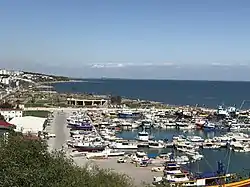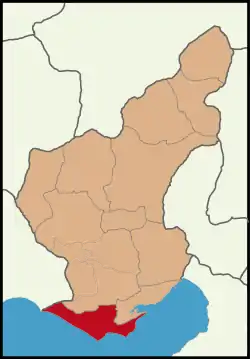Karataş
Karataş (Greek: Μέγαρσος, Mègarsos) is a small city and a district in Adana Province, on the Mediterranean coast of Turkey, 47 km from the city of Adana, between the rivers of Seyhan and Ceyhan, the Pyramos of Antiquity. The city of Karataş has a population of 8,483 (in 2010), with another 13,000 living in surrounding villages.
Karataş | |
|---|---|
City | |
 | |
 Location of Karataş within Turkey. | |
 Karataş Location of Karataş within Turkey. | |
| Coordinates: 36°33′45″N 35°22′49″E | |
| Country | |
| Region | Mediterranean |
| Province | Adana |
| Government | |
| • Mayor | Boğaçhan Ünal (CHP) |
| Area | |
| • District | 907.03 km2 (350.21 sq mi) |
| Population (2012)[2] | |
| • Urban | 8,592 |
| • District | 20,896 |
| • District density | 23/km2 (60/sq mi) |
| Time zone | UTC+2 (EET) |
| • Summer (DST) | UTC+3 (EEST) |
| Postal code | 01x xx |
| Licence plate | 01 |
| Website | www.karatas.gov.tr |
History
The area has been inhabited from at least Hittite times and probably earlier. It was later part of the Assyrian province of Quwê (Que). By the time of the Greeks, who knew the city as Megarsos/Magarso, there was a port here at the mouth of the navigable Pyramos, supplying an important military and trading route into the plain of Cilicia, and also providing access to the sea for the river towns, like Mallus. In 333 BCE, just before the battle of Issus, Alexander the Great sacrificed here at a temple that, by interpretatio graeca, he took to be of Athena; the "Athena of Magarsos" who appears on Hellenistic coins has been diagnosed, from her pose and the attributes that surround her, to have Mesopotamian connections.[3] Robin Lane Fox[4] recognizes the origin of the cult site in the victories of Sennacherib, who instituted the shrine in 696 BCE following a sea battle with Greeks off the mouth of the river;[5] he dedicated it to his martial goddess, Anat, or Ishtar.
The Romans rendered Magarsos as Megarsus. The port was later conquered by the Arab armies during the growth of Islam and then by the Ottomans in 1517.
Karataş was occupied by French troops during World War I.
Places of interest
- The ruins of churches, caravanserai, and an amphitheatre. However the ancient monuments remain to date in lack of proper research or preservation.
- The inlet of Akyatan is a breeding ground for many birds and the sea turtle species Chelonia mydas and Caretta caretta. Karataş is particularly important for the latter, which is an endangered species that lays eggs primarily in Akyatan, another beach in neighboring Yumurtalık district and İztuzu Beach in Dalyan in southwestern Turkey.
Karataş today
Today Karataş is known for its fishing industry and as a place that Adana's inhabitants can easily access to relax on the beach. There are also rich farmlands behind the coast where cotton, watermelons, melons and other crops are grown.
The well-known footballer Hasan Şaş is from Karataş and has a street named after him in memory of his excellent performance for Turkey national football team during the 2002 World Cup.
Brussels-based painter Nazife Can is also from Karataş.
References
- "Area of regions (including lakes), km²". Regional Statistics Database. Turkish Statistical Institute. 2002. Retrieved 2013-03-05.
- "Population of province/district centers and towns/villages by districts - 2012". Address Based Population Registration System (ABPRS) Database. Turkish Statistical Institute. Retrieved 2013-02-27.
- Arthur Houghton, "The Seleucid mint of Mallus and the cult figure of Athena Magarsia", inA, Houghton, S. Hester et al. (eds.) Festschrift für /Studies in Honour of Leo Miildenburg1984 :99-110. 1984:99-110, noted by Fox 2008.
- Fox, Travelling Heroes in the Epic Age of Homer, 2008:82f.
- The monument to his land victory, Robin Lane Fox observes, was at Anchiale,
External links
| Wikimedia Commons has media related to Karataş. |
- District governorate's official website (in Turkish)
